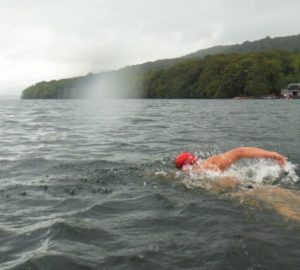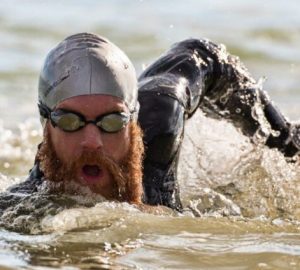How to support the creation of a Marine Conservation Zone in Studland Bay
Image: Seahorse Swim 2017
It’s a fairly safe assumption that most of us who swim do so because we enjoy it – or at least some aspects of it. At times, swimming is so amazing, it feels self-indulgent. That is especially the case when we swim outside in beautiful locations – the times when you think: “I’m so grateful I can swim, and I can swim here!”
But, if we want to keep swimming in these special places, we may need to help protect them.
Last weekend I took part in the fabulous Seahorse Swim in Studland Bay, Dorset. In some ways, it’s a routine swim. You can either swim one lap around a set of buoys for 2km or 2 laps for 3.8km. It’s just laps around buoys – a format (and distance) that’s more aligned with triathlon than open water swimming. Yet this feels like a swimmer’s swim, not a triathlete’s swim. This is primarily because it’s run by the East Dorset Open Water Swimming Club (EDOWSC), whose volunteers help create a wonderful, friendly atmosphere. The post-swim raffle also ensures lots of people stick around for a chat and prize-giving afterwards.
A key draw, however, is the location. Studland Bay is simply a lovely place to spend the day, both in the water and on the beach. One of the reasons EDOWSC chose the location is because it’s sheltered and relatively shallow, and therefore attractive for swimming.
The event is named the Seahorse Swim because seahorses actually live and breed in Studland Bay, and part of the money raised from the swim is donated to the Seahorse Trust (other beneficiaries are the National Trust and the RLSS). It is only relatively recently that it was known that certain seahorse species inhabit UK waters as they are primarily found in shallow tropical and temperate waters. Studland Bay also features seagrass, which not only supports the seahorses but is also a habitat and nursery for many other fish. Since the swim started in 2010, it has raised almost £5,000 for the Seahorse Trust.
The Seahorse Trust, along with the Dorset Wildlife Trust, is campaigning to have Studland Bay designated as a Marine Conservation Zone, and you can support this campaign by emailing the Department for Environment, Food & Rural Affairs (see below for email address).
The two species of British seahorses have been protected since 2008 under the Wildlife and Countryside Act, which means it’s illegal kill, take or disturb seahorses in British waters, so there are legal incentives to designate Studland Bay as an MCZ. Seahorses face multiple threats from souvenir collection to being used in some forms of traditional medicine and habitat loss.
Habitat damage can occur from boats anchoring above seagrass as anchor chains can scour the sea bed and uproot the grass. One benefit to creating an MCZ would be to prevent such damage and push boat users towards “eco moorings”, which are safer for the environment.
Time is short as decisions on the creation of new MCZs will be made over the next few weeks and the deadline for comments is 20 July 2018.
Neil Garrick-Maidment of the Seahorse Trust says: “We need everyone to show their support for the nomination and, with stronger support, Studland Bay has more of a chance of becoming an MCZ. To show your support please send your comments to mcz@defra.gsi.gov.uk or alternatively, if you have evidence to support your comments, please complete the consultation survey.”
For further information on The Seahorse Trust look for “theseahorsetrust” on Facebook or visit their website at www.theseahorsetrust.org
DEFRA has published a fact sheet about the proposed MCZ in Studland Bay.
More information on the broader campaign for MCZs can be found on the Marine Conservation Society’s website, along with a template email to send to Michael Gove.
https://www.mcsuk.org/campaigns/new-41-marine-conservation-zones







